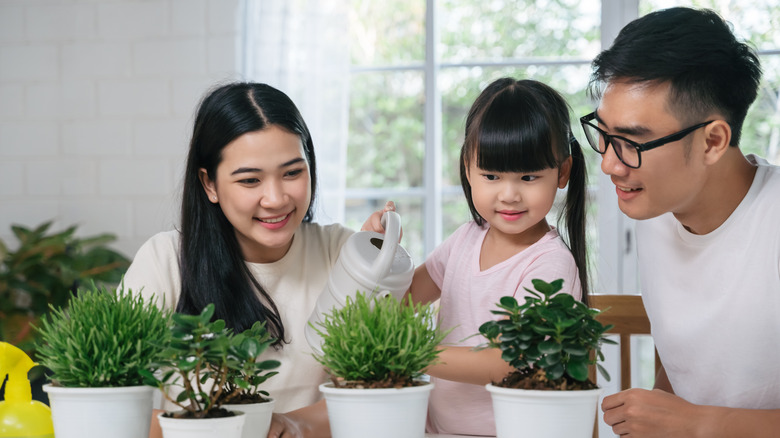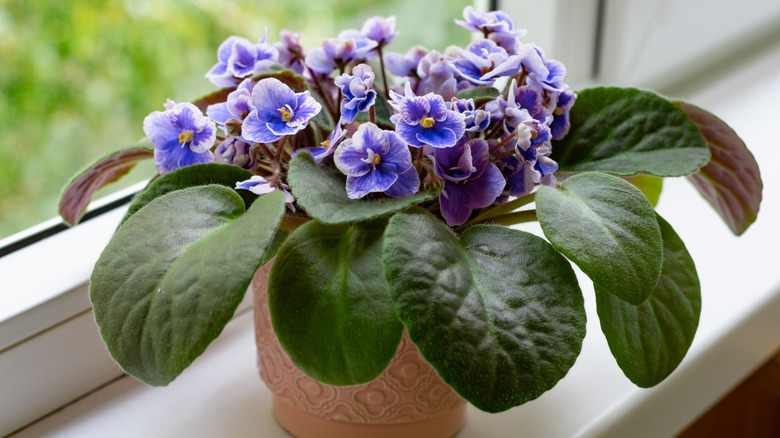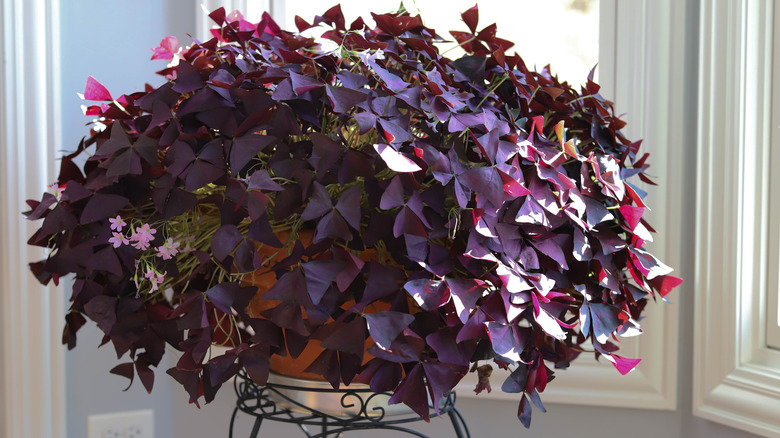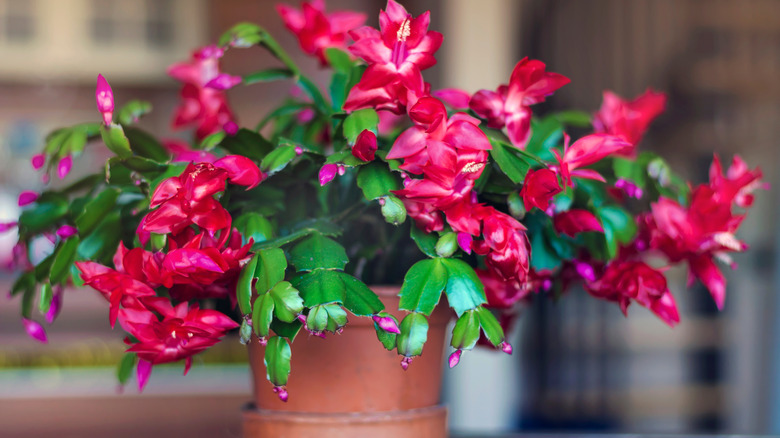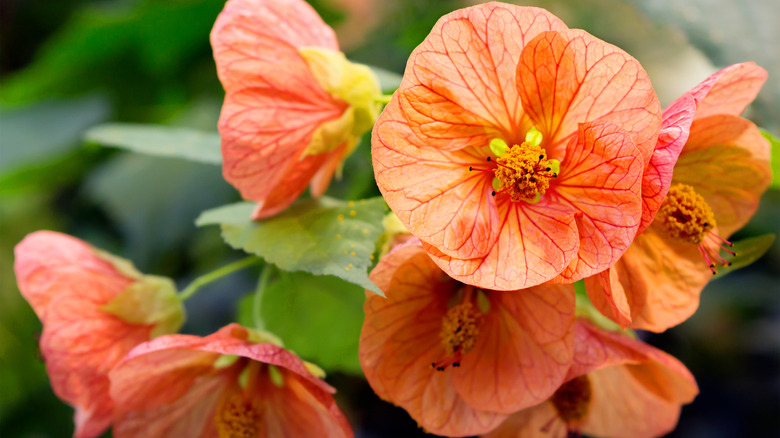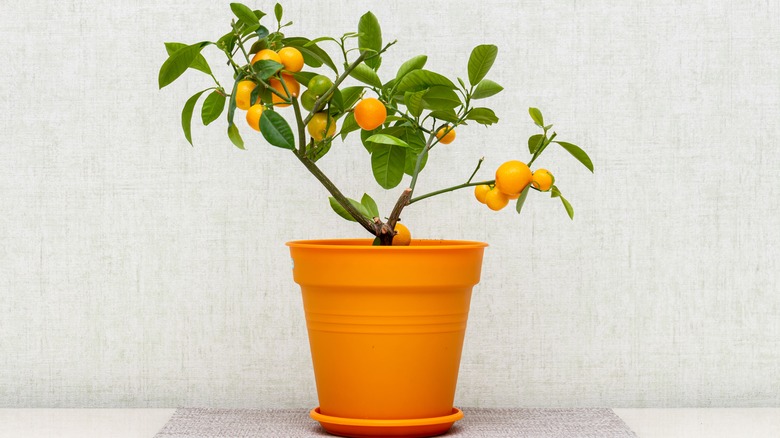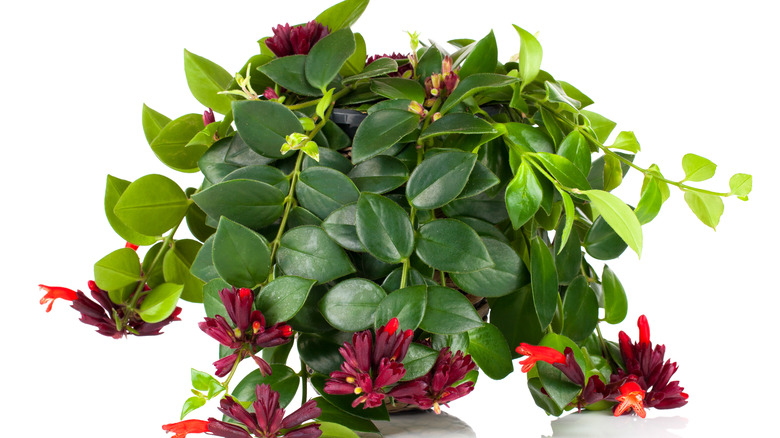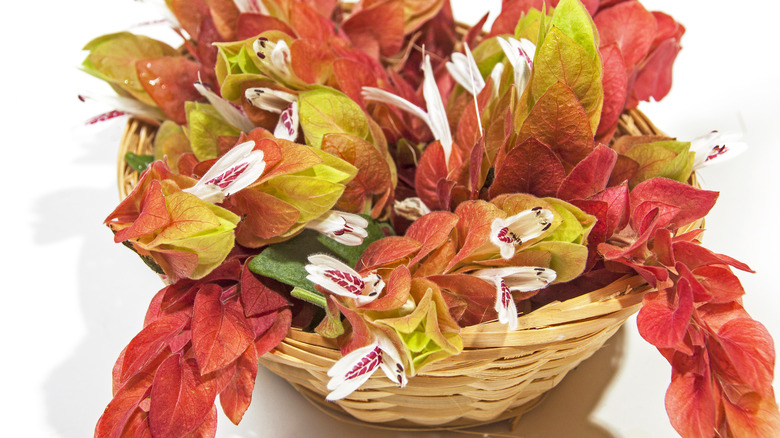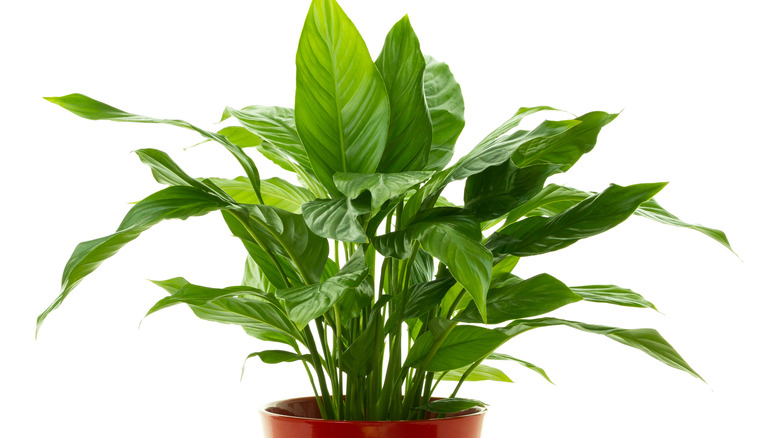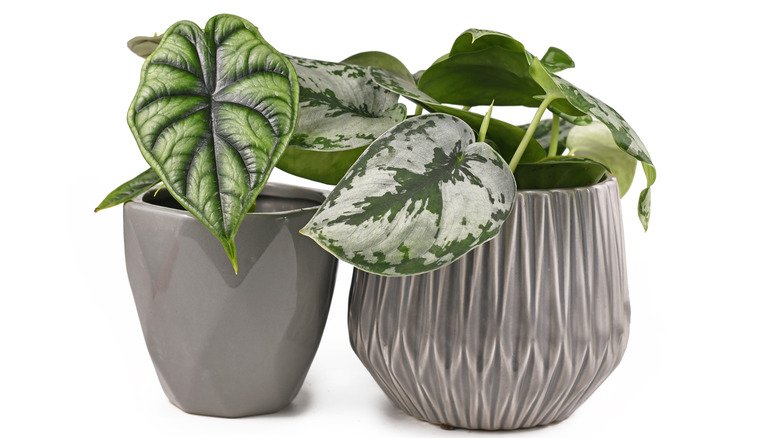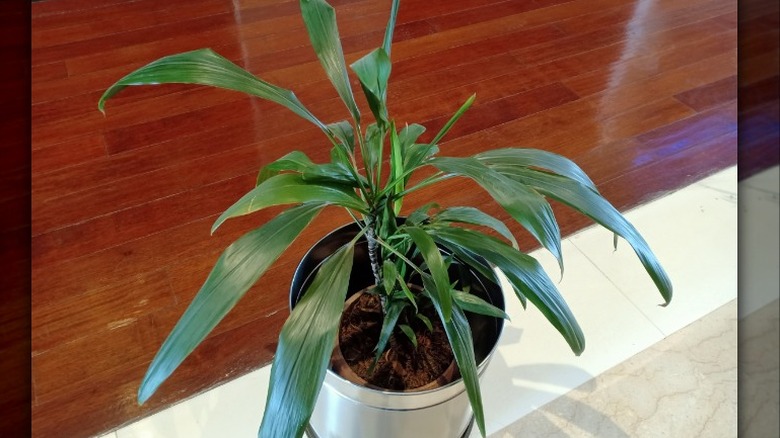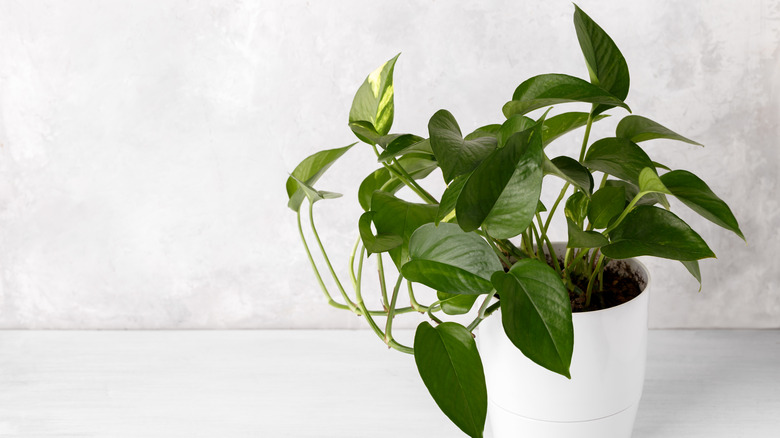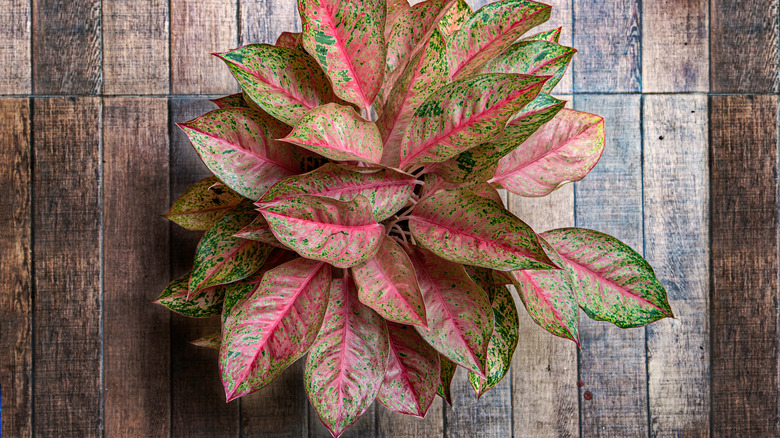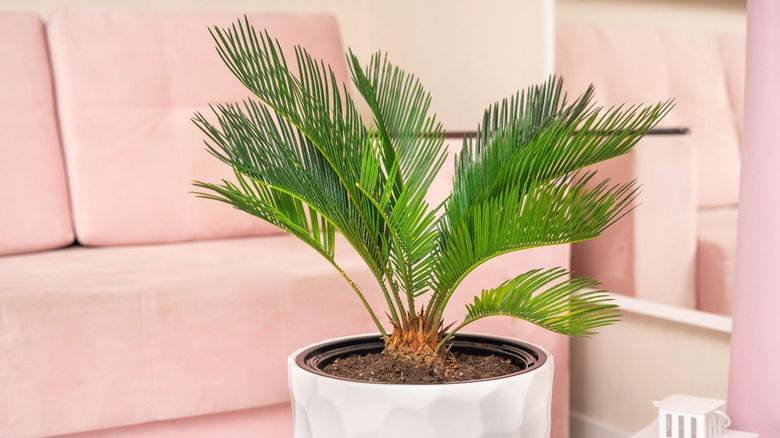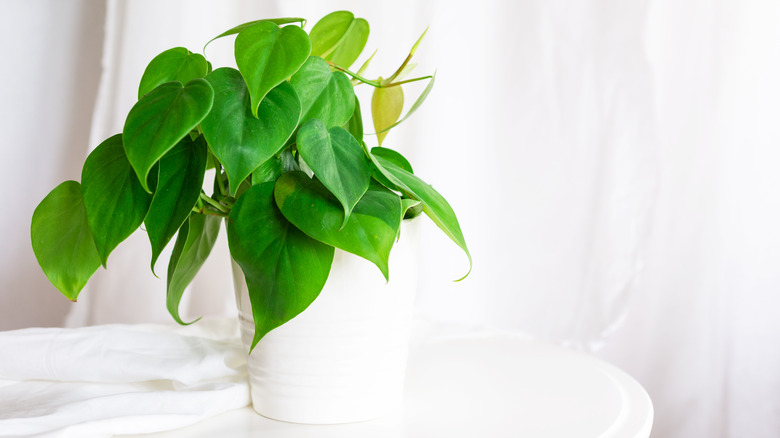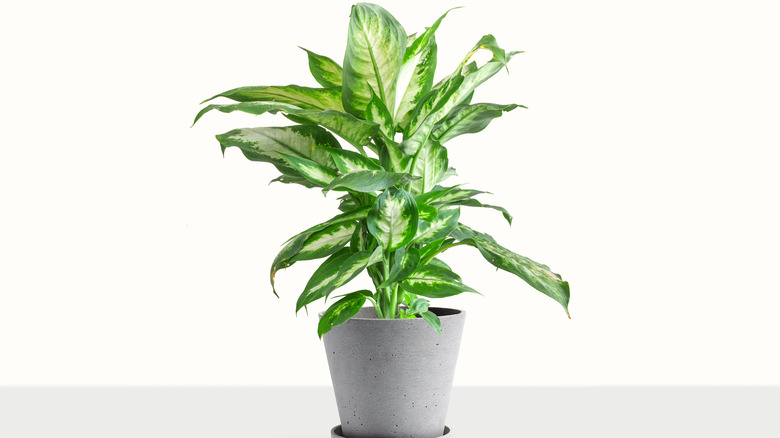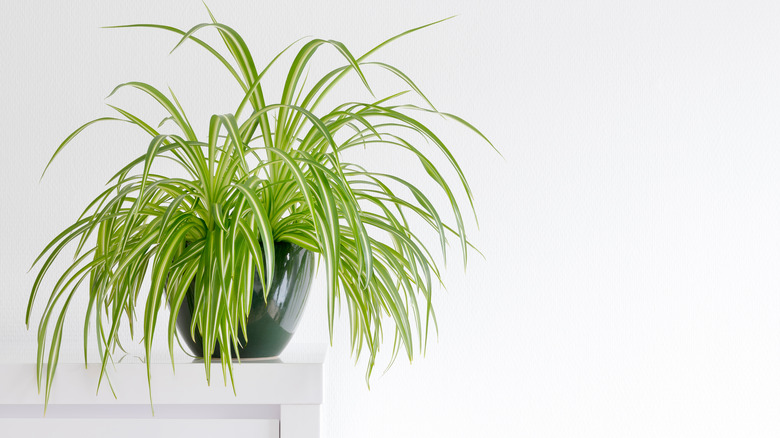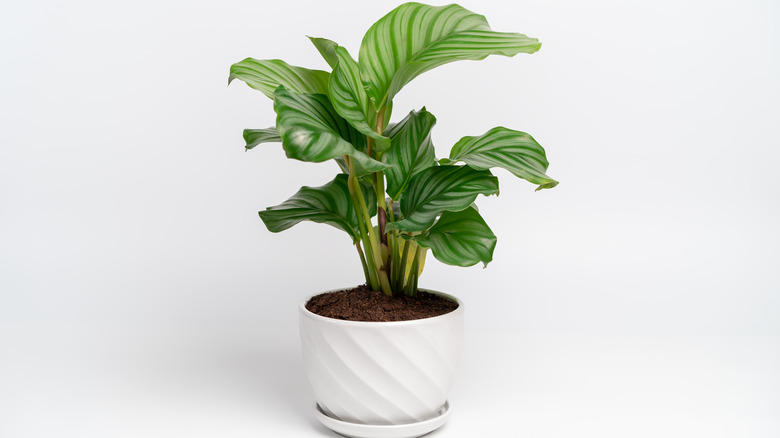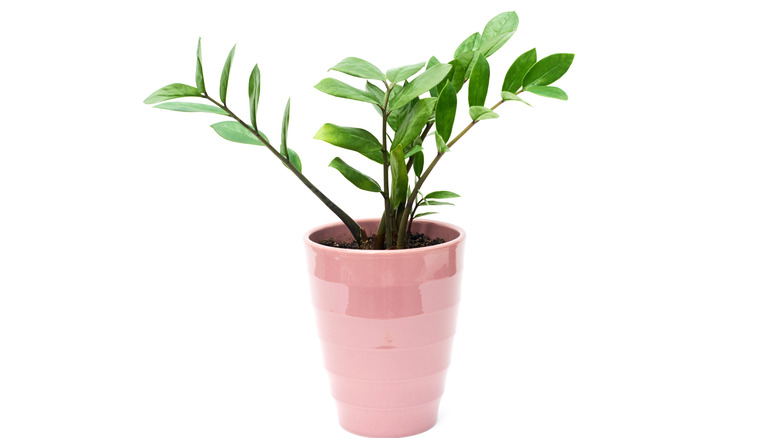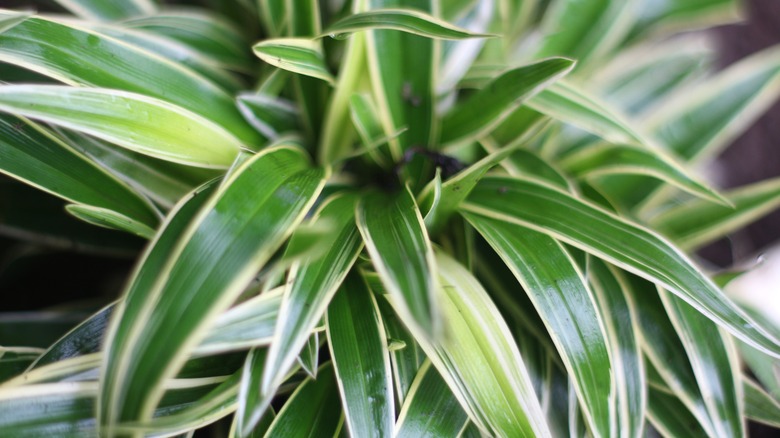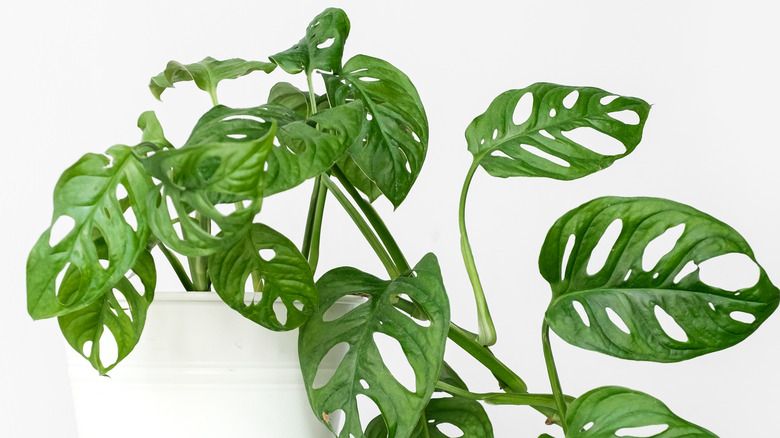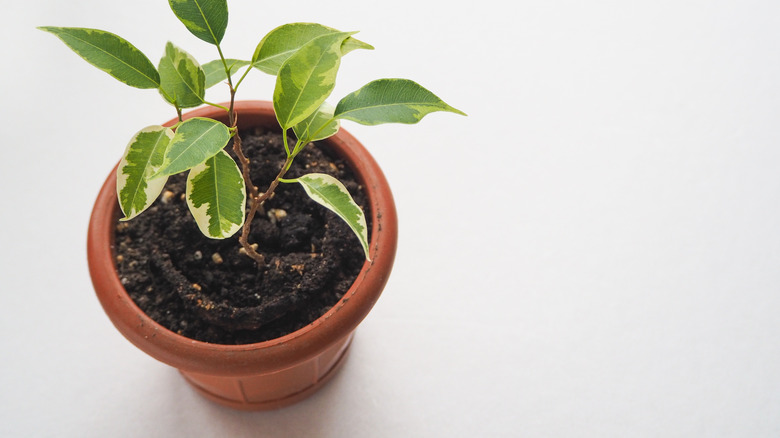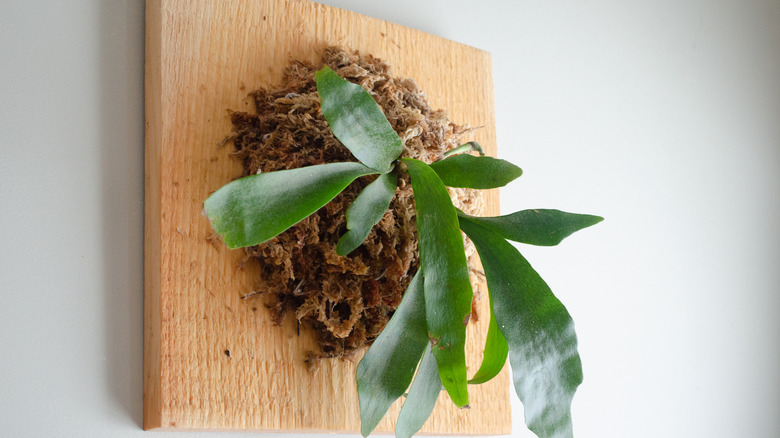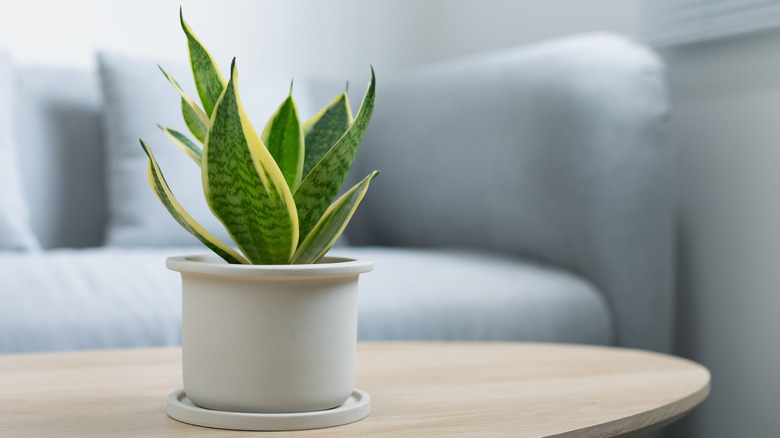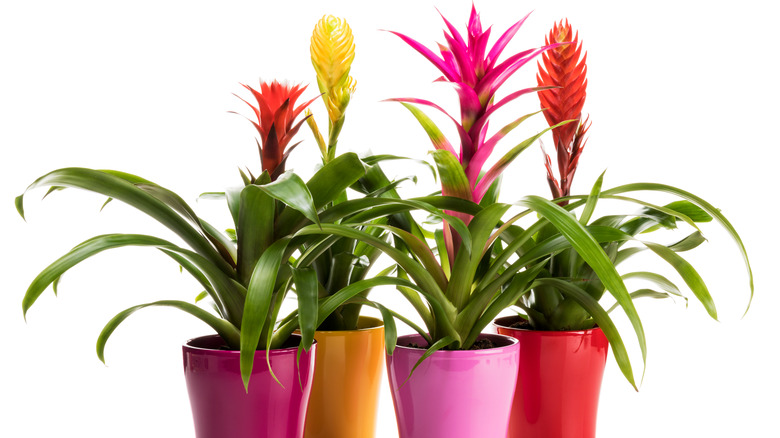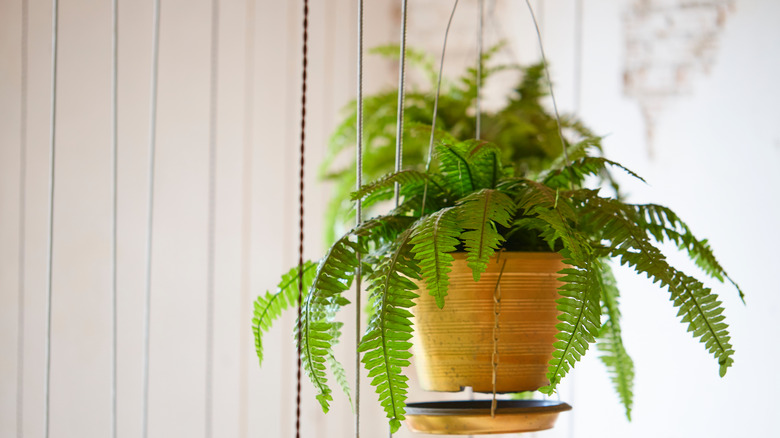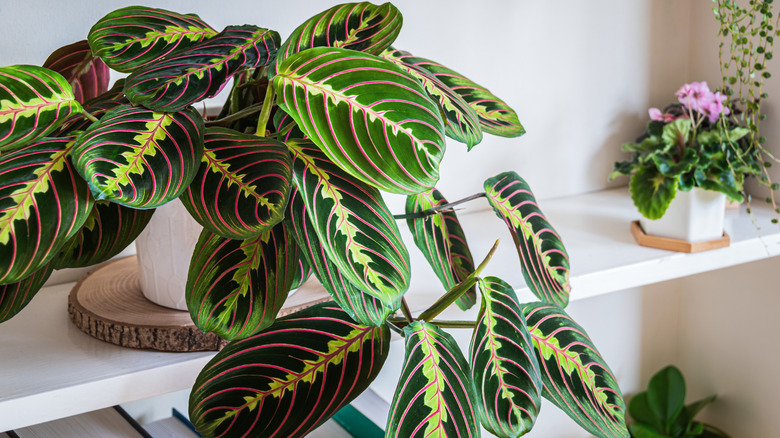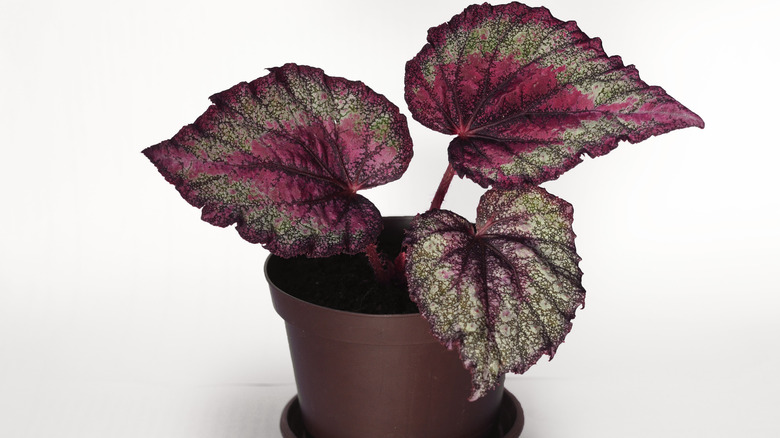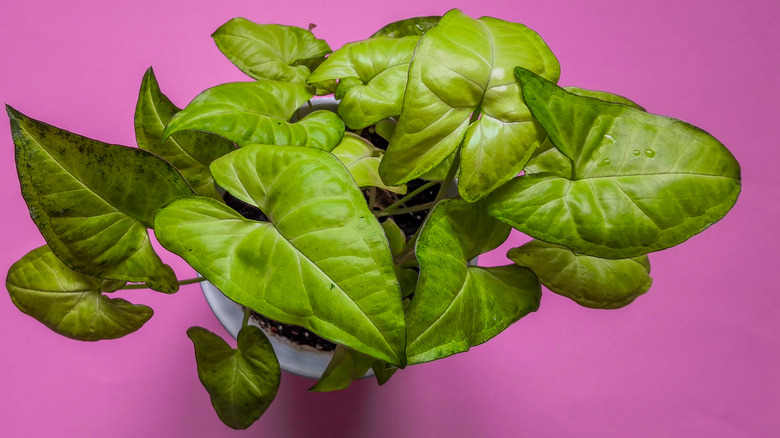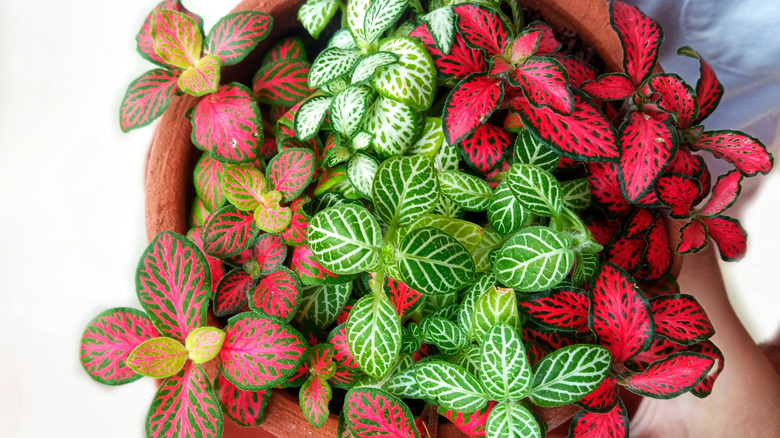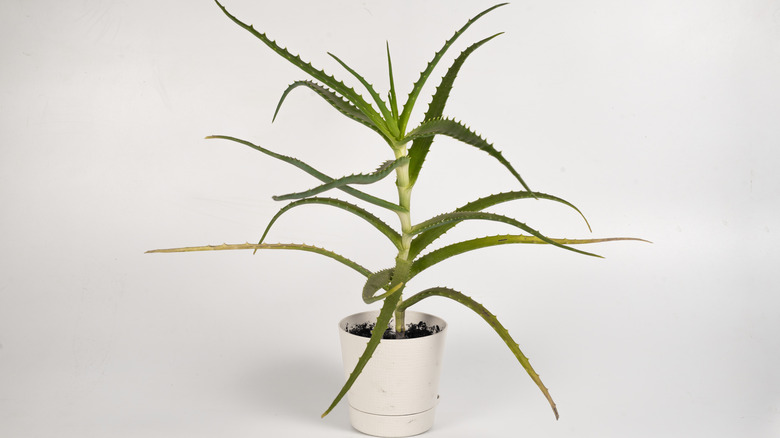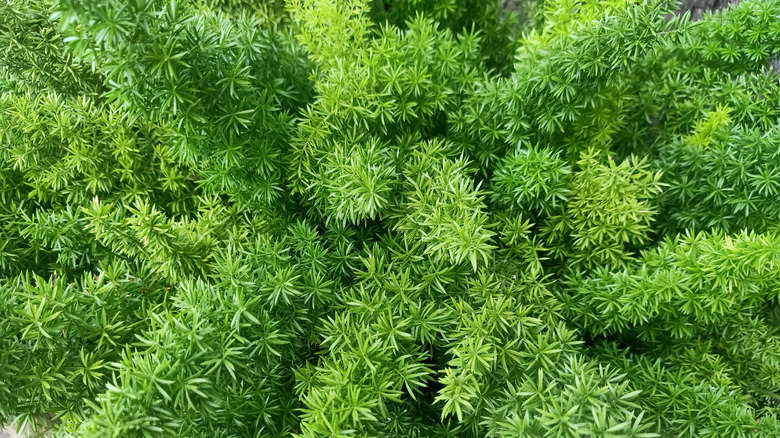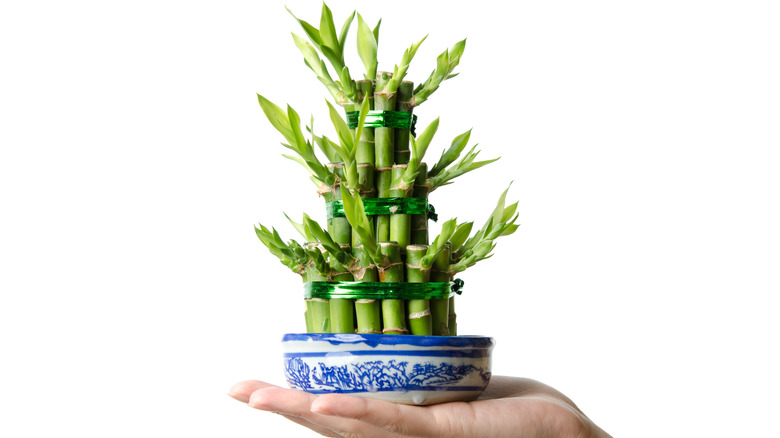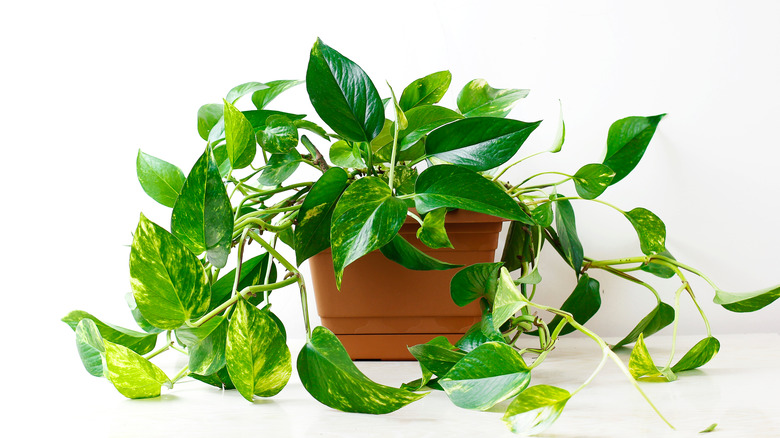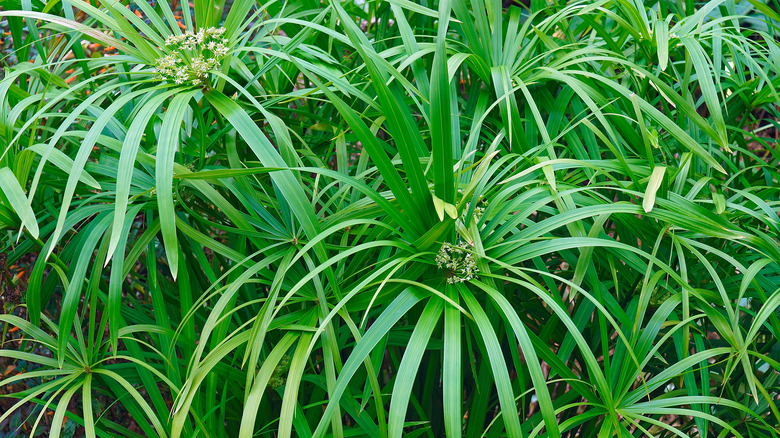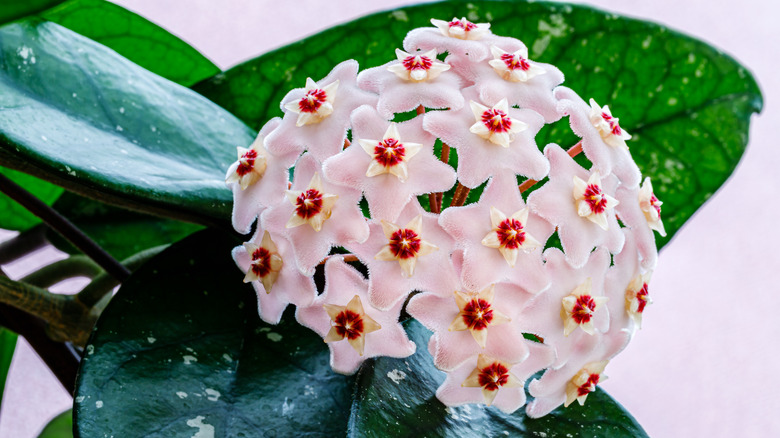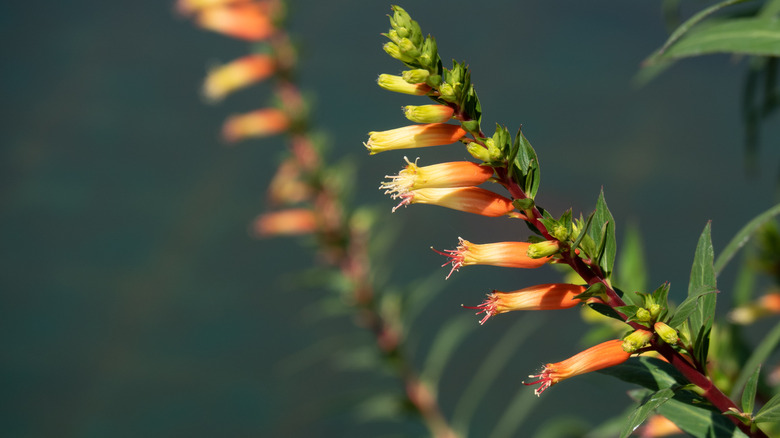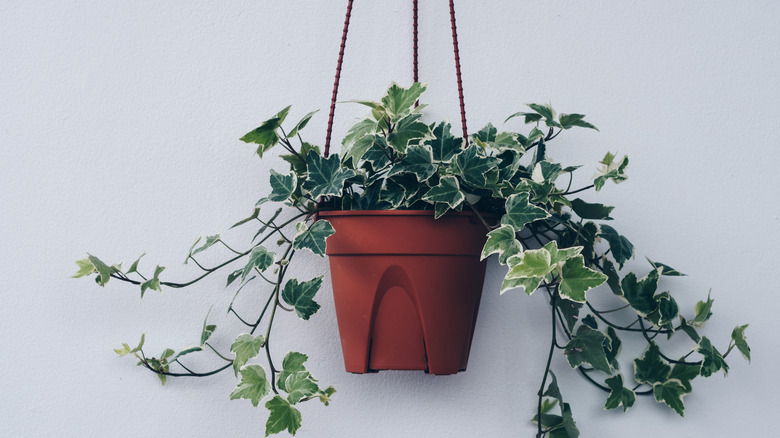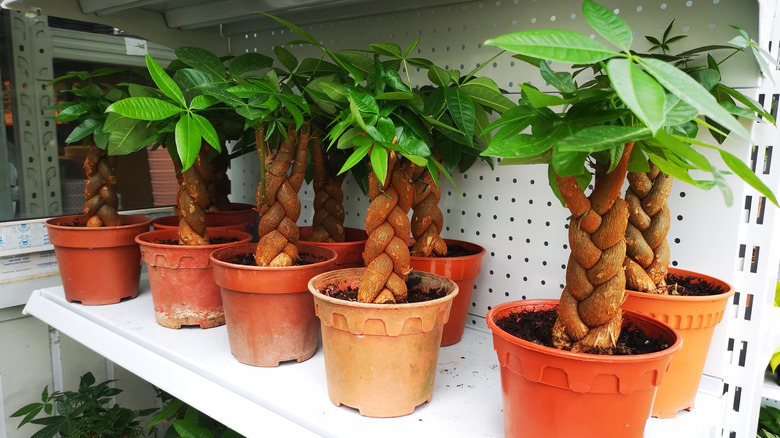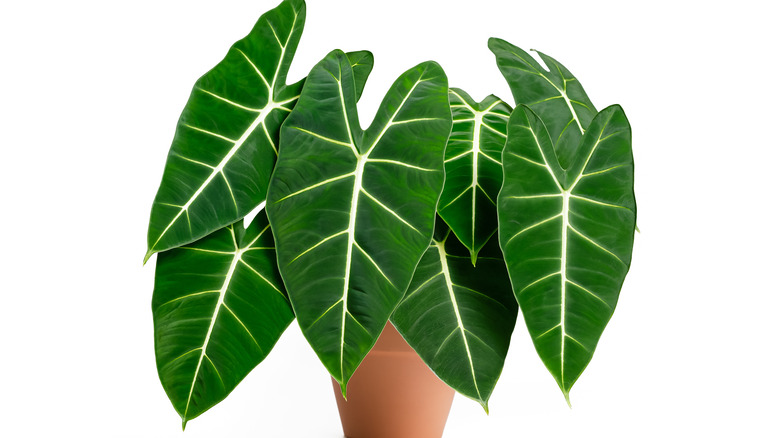40 Of The Best Low Light Plants To Grow Indoors
Stocking up on indoor plants and positioning them in your home properly will brighten up the rooms, wow your guests, and make it look like you decorated your home professionally. But then, let us also be honest: Synthetic plants don't give many of these benefits, unlike the real thing. Of course, tending to living plants generally requires dedication, time, and effort. However, Ambius says that indoor plant upkeep is relatively easy if you consider the health benefits. For instance, The Sill says growing a plant or two indoors increases the oxygen levels in your home, reduces fatigue, lowers stress and anxiety levels, and improves performance and focus. Do you see? It's not just about aesthetics.
Now, hollup! Not every plant should be indoors; some are space-demanding, others need babysitters, and there are toxic air polluters, too. To make sure you make the right choice, we have created an A-List of the 40 best low light plants to grow indoors. You could choose to plant yours from the seed (it's fun to watch your plant babies grow) or purchase pre-potted plants (although when they grow, you need to change the pot). In all you do, be sure to choose plants that suit your style, needs, and long-term goals.
1. African violet
When keeping low light indoor plants, you're mostly thinking long-term, and the African violet (saintpaulia ionantha) fits that job description. With the capacity to live up to 50 years, all you have to do to this purple blooming flower is know how and when to play your part with repotting, container size, and recommended soil type, says Gardening Know How. Also, through photosynthesis, the African violet purifies the air by replacing essential gasses such as oxygen, says Flower Shop Network.
Sunlight Needs: low light
Water needs: tap water, sparingly
2. Oxalis
Loved for its vibrant burst of color, Oxalis (oxalis triangularis) is also called shamrock or love plant, and if treated right it will return the favor. However, if not adequately cared for, oxalis recedes into the dormant phase and may eventually die. According to The Sill, if you are generous with the fertilizer and light exposure, your love plant should do just fine. Also, Food Thesis explains that oxalis is a healthy replacement for lab-formulated food coloring. Talk about useful!
Sunlight Needs: low dappled light
Water needs: twice a week
3. Christmas cactus
Christmas cactus (schlumberger) doesn't hold back in sharing the Christmas spirit. According to Good Housekeeping, once pampered and exposed to minimal light, Christmas cacti burst to life in red, yellow, and white, contrasting with the green stems. And when it blooms, this flower emits oxygen at night to make for better naps, according to First For Women.
Sunlight Needs: low light
Water needs: twice a week
4. Flowering maple
"I'm back, gardening mamas!" screams the flowering maple (abutilon x hybridum) as it shows up in the garden once again in its revered, large evergreen structure. Popular in the Victorian age, flowering maple fell out of favor only to resurrect in modern gardening in a plethora of forms, says Wisconsin Horticulture. This low light, scent-emitting plant is also a great mood booster, which is why we at House Digest and White Flower Farm recommend it for your living and working space.
Sunlight Needs: low light
Water needs: once a week
5. Calamondin orange
Beside being an excellent indoor decoration that fills the air with its delicious, citrus-like scent, calamondin orange (citrofortunella microcarpa) also bears edible fruits. The flower is drought-tolerant, but according to Gardening Know How, you have to water it during extended dry periods. Calamondin orange may just be one of the very few fruit-bearing plants that actually thrive in low light; yes, we love the trailblazers.
Sunlight Needs: low light
Water needs: once a week
6. Lipstick plant
Lipstick plant (aeschynanthus radicans) gets its name from its flowers which are like the red lipsticks used in the '80s. This flower used to be all the rage but fell out of favor with most gardeners. Well, we think that is unfair and Urban Sprouts do too, explaining how the lipstick plant's vine-like habit makes it super easy to maintain and suitable for hanging in baskets at home. However, if you are seeking flowers to add scents to your house, nah this ain't it, says The Spruce.
Sunlight Needs: low light
Water needs: once a week
7. Shrimp plant
With proper cultivation, shrimp plant (justicia brandegeana) provides you with color, life, and the "designed to impress" pride of owning an ornamental plant. And unlike most ornaments that are notoriously difficult to cultivate and maintain, this one, according to Assaggio, doesn't boss you around. Thinking of adding nature-given class to your lounge? We recommend that you strategically add pots of shrimp plant that you can show off to everyone who comes calling.
Sunlight Needs: low light or partial shade
Water needs: twice a week
8. Peace lily
Want to learn the art of consistency? Almanac claims that with peace lily (spathiphyllum spp.) consistency is key. Yes, it is what it sounds like, the peace lily is highly picky: For it to bloom and peace to reign, you have to recreate in your home the same dappled sunlight and moisture that it is familiar with inside the forest. Your reward? Exquisite white blooming flowers. According to Balcony Garden Web, peace lily helps prevent mildew growth and purifies the air.
Sunlight Needs: low light
Water needs: every two to three days
9. Silver satin
Silver satin pothos (scindapsus pictus) is one of our favorite indoor plants with a glossy silver finish and green patterns that your visitors cannot get enough of. Garden blogger Brittany Goldwyn recommends this as a must-have indoor plant for good reasons: Silver satin thrives well in low light, lives long, and does not require as much fertilizer as is rumored. According to Dazed Digital, this plant is excellent for city dwellers who want to connect with nature, and if we may add, brown thumbs too!
Sunlight Needs: low light, partial shade
Water needs: once a week
10. Cast iron plant
Not everyone has a green thumb, but this doesn't mean brown-thumbed individuals can't own indoor plants as well, as long as cast iron plant (aspidistra elatior) still exists. According to The Spruce, cast iron stays green all day every day! It can handle deep shade, but you have to avoid overwatering it. We recommend potting in a cracked pot so excess water gets drained. Got that? Yup, you are good to go!
Sunlight Needs: low light
Water needs: twice a week
11. Devil's ivy
Mr. Plant Geek calls the devil's ivy (Epipremnum) a houseplant that's easy to grow; it thrives on neglect and low light. A bit dramatic? Actually, no, he's right. Devil's ivy can grow anywhere — on moss, cement, stalks, and more — and even if you leave this it in the dark, it'll remain evergreen. Talk about some independent vibes. Mostly, the only time you need to water it is when it feels dry to touch, says Patch.
Sunlight Needs: low light
Water needs: twice a week
12. Chinese evergreen
The Chinese evergreen (Aglaonema commutatum) is an air-purifying houseplant often chosen for its aesthetics and color variations. While it does not come in all colors, Chinese evergreen boasts a beautiful dark green and sometimes a unique silver red. According to The Spruce, Chinese evergreen produces excellent, healthy green foliage which can be catered to all through the year.
Sunlight Needs: low dappled light
Water needs: twice a week
13. Sago palm
Want to bring some tropical Japanese vibes into your home? Grow sago palm (Cycas revolutas.) Sago palm thrives best in cooler climates which makes them excellent low light plants. The only catch, according to House Plants Expert, is that they grow slow, painfully so! Therefore, if you want one ASAP, you may just have to buy a full-blown potted sago palm. However, it'll be a fun experience growing one from the ground up. Also, when consumed, sago palm could help to lower the risk of heart disease and provide antioxidants to the body, says Healthline.
Sunlight Needs: low dappled light
Water needs: once a week
14. Heartleaf philodendron
The sweetheart plant, also known as heartleaf philodendron (bipinnatifidum) or otherwise, is quite the trickster. First, it sprouts glossy, bronze, heart-shaped leaves that quickly turn green — who does that? Anyway, heartleaf philodendron makes an excellent indoor plant with the ability to adapt to shade. However, according to Gardening Solutions, heartleaf philodendron can be lethally toxic when eaten not and may not be the best option to have around pets or little kids. To get the most of the sweetheart plant, Guide to Houseplants highly recommends pinching as a caring technique.
Sunlight Needs: low dappled light
Water needs: two to three times a week
15. Dieffenbachia
Dieffenbachia (dieffenbachia seguine), also called the dumb cane or leopard lily (because of its spots) is surprisingly quite exquisite. This is an excellent household plant with ability to absorb carbon dioxide and, as a result, render the air dry and purified, says Balcony Garden Web. Also, dumb cane creates a tropical look, you know, if you ever want a lil' bit of the Amazon in your home.
Sunlight Needs: partial sunlight
Water needs: twice a week
16. Spider plant
This plant's name refers to multiple leaves that sprawl out of the pot that mimic the many legs of a spider as it grows. Spider Plant (Chlorophytum comosum) is an excellent indoor plant with multiple benefits to offer. Its most unique benefit, however, is the ability to detoxify your home from formaldehyde which is present in house paints, says Garden Beast.
Sunlight Needs: low light
Water needs: two to three times a week
17. Calathea
If you have a thing for patterns, the calathea (herbaceous perennial) is a houseplant you'll love for its excellent foliage, which provides a nice contrast to any interior. According to Apartment Therapy, the major cons of this plant include the browning of the tips and infestation by gnats. But not to worry, if these ever happen to you, all you have to do is to cut the leaves for a new sprout and replace the topmost soil with diatomaceous earth.
Sunlight Needs: low dappled light
Water needs: once every two weeks
18. ZZ plant
Looking for a plant that you can abandon for as long as you want, and that will always be right where you left it? The ZZ Plant (zamioculas zamifolia) fits that description perfectly. According to Gardinista, its waxy smooth leaves take your interior up a notch by reflecting sunlight. Yes, we love it. Also, Balcony Garden Web emphasizes the air-purifying nature of this plant; it absorbs carbon dioxide and other pollutants such as xylene and toluene.
Sunlight Needs: low light
Water needs: three times per week
19. Dracaena
Dracaena (dracena fragrans) comes in all sizes and has an upright shape. While there are a plethora of species, the houseplant variety of dracaena is dracaena fragrans. This plant requires a standard level of care (potting, pruning, and fertilizing). Serenata Flowers insists that these plants help aid focus as well as boost your mood and reduce anxiety. With that said, we believe that you need this in your working space!
Sunlight Needs: partial shade
Water needs: two to three times a week
20. Monstera plant
Monstera (karsten annum) is a popular indoor plant with holey leaves. Unlike in other plants where holes in leaves is an indication of termite infestation, monstera leaves have holes naturally (whether healthy or infested) and are therefore called swiss cheese plant. According to Petal Republic, aside from purifying air, monstera is also a good air humidifier, which kicks out toxins and odor from your home. Additionally, monstera is another trailblazing houseplant bearing delicious fruits that are rich in vitamins B and C, as well as calcium. However, if eaten before ripening, the fruits can be poisonous, says Get Goldoon.
Sunlight Needs: low light
Water needs: twice a week
21. Weeping fig tree
Weeping fig tree (ficus benjamina) makes the list with its quirky growth pattern indoors. It is relatively small in size and is one of the most powerful air-purifying plants, says Bourne Valley Garden Center. However, weeping fig tree can be quite toxic to your animal pets, causing oral irritation and abnormal drooling when introduced to the mouth, says Kitsap Humane.
Sunlight Needs: low light
Water needs: once a week
22. Staghorn fern
Staghorn ferns (platycerium bifurcatum), though difficult to grow, are quite popular in modern-day indoor plant collections because they are the perfect wall-mounted, natural décor. Staghorn is watered once a week, as it is mostly sapping moisture, strong odor, and toxins from the atmosphere, says Our House Plants. This plant gets its name from its antler-like resemblance, says The Spruce.
Sunlight Needs: low light
Water needs: once a week
23. Snake plant
If plants were high school stereotypes, snake plant (sansevieria spp.) would be a sneaky link, literally. Gardening Know How gives this plant the award for being extremely tolerant, blazing like a green tongue of fire when potted and employed as table décor. Also, it comes in a variety of species, but sansevieria spp (which has the lowest light tolerance and boasts a sturdy architectural shape) is the most famous of its breeds. According to a study undertaken by NASA, Bloomscape reports, this plant replaces toxins such as benzene and formaldehyde with cleaner oxygen.
Sunlight Needs: low light
Water needs: twice a week
24. Bromeliads
This plant is an outlier. Technically speaking, the bromeliads (cryptanthus) do not need soil to thrive! How cool is that? Get Busy Gardening says that they can grow on logs, pots, cement, etc. — all they need is a foundation for their roots. This gets interesting because you do not need to worry about soil type or depth when potting, making bromeliads the type of plants to grow indoors. However, for best results, we and Plantophiles recommend a bromeliad potting mix. The bromeliad is also a great houseplants if you have pets because they are absolutely non-toxic.
Sunlight Needs: low light
Water needs: once or twice a week
25. Sword fern
Sword fern (polystichum munitum,) AKA Boston fern, is one of the oldest plants on the planet, Food Thesis writes. Old but sexy, sword fern adapts to changes and could be used as ceiling-hung décor grown under low light and moist conditions. Sword fern has characteristic medicinal purposes in cleaning sores, says the Lake Wilderness Arboretum. Note: Whenever you notice your sword fern wilting, it's just about to reproduce even more leaves, so don't panic — or should you?
Sunlight Needs: partial shade
Water needs: two to three times a week
26. Prayer plant
In need of a dramatic household plant that's satisfying to watch all day? We think you should go for one of the three species of prayer plant (Maranta leuconeura.) The prayer plant gets its name from the leaves' behavior of laying flat during the day and folding up like praying hands at night, as stated by Better Homes & Gardens. Also, these are super helpful houseplants because of their medicinal properties (anti-inflammatory and anti-bacterial,) says the Petal Republic.
Sunlight Needs: low light
Water needs: twice a week
27. Rex begonia
Although prized for their aesthetics, in a world of increasing air pollution, we believe you will gain more than eye candy from the rex begonia (Herbaceous perennial.) According to Homestead Gardens, they are great value plants with four of them costing under a dollar, but that's not all. They are also adaptive to various growth conditions: hanging, potting, and even in the garden. Urban Planters also writes that this flower purifies the air from harmful toxins.
Sunlight Needs: low light
Water needs: every five to seven days
28. Arrowhead plant
Looking for a plant that has it all? Well, that may be hard to find, but we could cut you a pretty great deal with the arrowhead plant (Syngonium podophyllum.) This easy-to-grow plant is an excellent C02 absorber, which makes for an excellent air dryer and toxin remover. It can also grow excellently in water, and the icing on the cake is that it's an excellent climber plant, writes Balcony Garden Web.
Sunlight Needs: partial shade
Water needs: 2 to 3 times a week
29. Fittonia
Fittonia (Fittonia aliveness), also known as nerve plant, is a bundle of joy to behold in six varieties, according to Greenkosh. Absolutely all of them have a thing for humidity, thus making them great low light plants for growing indoors. However, fittonia would almost need a babysitter, according to Apartment Therapy. Neglect the little fella in terms of watering and watch it wilt to death.
Sunlight Needs: low light
Water needs: every three to four days
30. Aloe
Seriously, you could not find a better indoor companion than the aloe (aloe arborescens); its succulent leaves are handy in terms of treating kitchen burns and scrapes, writes Almanac, which make this plant a must-have. Aside from the need for direct low light and continual watering, this plant isn't much of a fuss. However, the only catch is the fact that aloe has to be planted properly.
Sunlight Needs: low light
Water needs: twice a week
31. Asparagus fern
Add asparagus fern (asparagus aethiopicus) to your collection and have visitors wonder in amazement. According to The Spruce, asparagus fern is one of the least common plants to grow indoors due to its invasive nature. However, if you get it just right with pruning, you'll be just fine. Also, if they ever get invaded by termites, insecticidal soap should fix that problem, writes Houseplant 411.
Sunlight Needs: low light
Water needs: every two to three days
32. Philodendron micans
We know philodendron micans (Hederaceum var. hederaceum) looks a lot like heartleaf philodendron, but have you felt its velvety finish? This plant is absolutely exquisite and classy, writes By Brittany Goldwyn. If you're shooting for climbers, place a pot of philodendron micans near a pole and watch it grow and dance around it like a pole dancer, says Houseplant 411. Caution though, as philodendron micans can be toxic and should be hung in locations far away from kids or pets.
Sunlight Needs: partial shade
Water needs: two to three times a week
33. Lucky bamboo
Lucky bamboo (dracaena sanderiana,) which is not exactly bamboo, is a member of the dracaena family known to bring good luck, fortune, and wealth (via Love To Know.) Amazing aesthetics for homes and offices, lucky bamboo can be trained into shapes and designs of all kinds such as a swirl, a heart, a braid, and other designs, writes ProFlowers. Lucky bamboo can be a little more care-demanding than the regular kind, so you better be ready. Basically, you don't want to choke it with water, and you'll need to apply liquid fertilizer to it every three to four weeks.
Sunlight Needs: low light
Water needs: twice a week
34. Pothos
Still on climbing plants, while the pothos (epipremnum aureum) does not naturally attach itself to objects, it can be trained to do so to give the appearance of twining, writes The Spruce. This plant, according to Bloomscape, thrives best in warm and humid temperatures of about 65 to 85 degrees: That is so hot! Anyway, you may want to keep pothos away from your pets as consumption could cause indigestion problems and dilation of pupils among other symptoms, says Gardening Know How.
Sunlight Needs: low light
Water needs: twice a week
35. Umbrella palm
There is a plant for every kind of gardener, so if you never quite get measurements right, the umbrella plant (cyperus alternifolius) is just for you. According to Gardening Know How, you can never overwater an umbrella, and although popularly an outdoor plant, you can successfully grow pots of it indoors.
Sunlight Needs: low light
Water needs: twice a week
36. Hoya carnosa
Native to Asia, hoya carnosa (epiphyte) is a vining plant that comes in many varieties. Aside from aesthetics, hoya carnosa is a the perfect choice if you have kids and pets everywhere. This plant thrive well in low light conditions, is non-toxic to human and pets, and according to Bloosmcape, it smells like vanilla, chocolate, or even cinnamon when it blooms. To care for hoya carnosa, all you have to do is water it each time it becomes 100% dry.
Sunlight Needs: low light
Water needs: twice a week
37. Candy corn plant
Candy corn plant (cuphea micropetala) is one of the cutest flowers to have blooming in your indoor garden. The candy corn plant makes our list for their capacity to look amazing and grow anywhere in the home — either in hanging baskets or in pots, says Guide to Houseplants. Candy corn plant is also an excellent companion plant during a curfew, writes Gardenia.
Sunlight Needs: low light
Water needs: every four to six days
38. English ivy
Typical at outdoor castles in England, English ivy (hedera helix) is fast becoming a modern indoor plant with its speedy climbing abilities and elegant appearance in hanging baskets. While growing them outdoors could be heavily invasive, English ivy is better controlled indoors, says My Domaine. English ivy requires moisture to thrive and that's just about it. However, according to ABC Every Day it can be mildly toxic to humans and pets, so you must be strategic about placement.
Sunlight Needs: partial shade
Water needs: two to three times a week
39. Money tree
Bring good luck into your home by planting a money tree (pachira aquatica) or two. While we wish the leaves of this tree were made of actual dollar bills, we could also settle for its ability to bring us luck, wealth, and vitality, as claimed by Bloomscape. And if that's not enough motivation, Home Beautiful says you'll find the braided trunk of this plant especially aesthetically pleasing. Besides, wouldn't it be great to be able to back up your claims each time you use the idiom, "I have a money tree growing in my house" among your friends?
Sunlight Needs: low light
Water needs: twice a week
40. Elephant ear
Whoever said "bigger is better" was definitely referring to the elephant ear (alocasia macrorrhizos.) This plant requires regular moisture and dappled sunlight to thrive well indoors, writes Almanac. For location, since Garden Design describes elephant ear as an excellent stand-alone plant, we recommend placing it in a corner, by the door, or in a corridor for its best interior effect.
Sunlight Needs: low light
Water needs: twice a week
